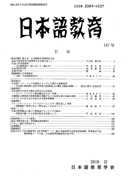Volume 178
Displaying 1-16 of 16 articles from this issue
- |<
- <
- 1
- >
- >|
FEATURED ISSUE: Tracing the Profile of Japanese Language Education Studies
-
2021 Volume 178 Pages 1-3
Published: April 25, 2021
Released on J-STAGE: April 26, 2023
Download PDF (782K)
Featured Articles
-
2021 Volume 178 Pages 4-20
Published: April 25, 2021
Released on J-STAGE: April 26, 2023
Download PDF (582K) -
2021 Volume 178 Pages 21-35
Published: April 25, 2021
Released on J-STAGE: April 26, 2023
Download PDF (599K) -
2021 Volume 178 Pages 36-50
Published: April 25, 2021
Released on J-STAGE: April 26, 2023
Download PDF (578K) -
2021 Volume 178 Pages 51-65
Published: April 25, 2021
Released on J-STAGE: April 26, 2023
Download PDF (499K) -
2021 Volume 178 Pages 66-78
Published: April 25, 2021
Released on J-STAGE: April 26, 2023
Download PDF (855K)
Reseach Papers
-
2021 Volume 178 Pages 79-93
Published: April 25, 2021
Released on J-STAGE: April 26, 2023
Download PDF (1348K)
REGULAR ISSUE
Reseach Papers
-
2021 Volume 178 Pages 94-108
Published: April 25, 2021
Released on J-STAGE: April 26, 2023
Download PDF (520K) -
2021 Volume 178 Pages 109-123
Published: April 25, 2021
Released on J-STAGE: April 26, 2023
Download PDF (503K) -
2021 Volume 178 Pages 124-138
Published: April 25, 2021
Released on J-STAGE: April 26, 2023
Download PDF (1149K) -
2021 Volume 178 Pages 139-153
Published: April 25, 2021
Released on J-STAGE: April 26, 2023
Download PDF (584K) -
2021 Volume 178 Pages 154-169
Published: April 25, 2021
Released on J-STAGE: April 26, 2023
Download PDF (750K)
Survey Articles
-
2021 Volume 178 Pages 170-184
Published: April 25, 2021
Released on J-STAGE: April 26, 2023
Download PDF (588K) -
2021 Volume 178 Pages 185-199
Published: April 25, 2021
Released on J-STAGE: April 26, 2023
Download PDF (584K)
Practical Articles
-
2021 Volume 178 Pages 200-214
Published: April 25, 2021
Released on J-STAGE: April 26, 2023
Download PDF (1676K) -
2021 Volume 178 Pages 215-229
Published: April 25, 2021
Released on J-STAGE: April 26, 2023
Download PDF (1513K)
- |<
- <
- 1
- >
- >|
